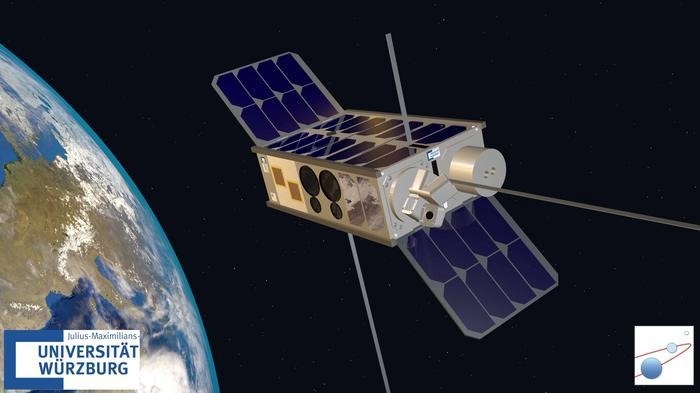
A model of the SONATE-2 nanosatellite, here artistically depicted in orbit. Image Credit: Hakan Kayal / University of Würzburg
After two years of development, the nanosatellite SONATE-2 is now ready to be launched and is expected to take place in March 2024. The satellite was designed and built by a team of aerospace engineers led by Professor Hakan Kayal from Julius-Maximilians-Universität (JMU) Würzburg in Bavaria, Germany.
JMU has dedicated around two decades to developing small satellite missions, and SONATE-2 represents yet another pinnacle achievement.
The satellite will test new AI hardware and software technologies in near-Earth space. The goal is to use it to detect anomalies on planets or asteroids in the future. The Federal Ministry of Economic Affairs has allocated a substantial 2.6 million euros to support this groundbreaking project.
Training the AI on Board the Satellite
According to Hakan Kayal, not many similar projects are currently being undertaken.
What is unique about our mission is that the AI is trained on board. Normally, this training is done on Earth with powerful computers. But this strategy does not fit the plans the JMU professor has in mind.
Hakan Kayal, Professor, Space Technology, University of Würzburg
Kayal added, “Let’s assume that a small satellite is to investigate a new asteroid in the solar system in the future. It cannot be trained for this task on the ground, because the object of investigation is largely unknown. There is no training data, so the measurements and recordings have to be made on the ground.”
Transmitting this data to Earth for initial processing and subsequently training the AI via remote control would result in significant time delays for missions located at a considerable distance from Earth.
Opting for a heightened level of autonomy with direct on-board AI support would greatly enhance the mission’s efficiency. This approach would expedite the detection of intriguing objects and phenomena on the asteroid, considerably reducing the time required for their identification.
SONATE-2 Tests Many Other Technologies
Kayal’s team aims to assess the feasibility of implementing such scenarios on SONATE-2, employing recently devised procedures and techniques, starting with trials in Earth’s orbit. To facilitate this, four on-board cameras capture the essential imagery required for training the AI.
Initially, the AI acquires knowledge of conventional geometric patterns on Earth’s surface, among other things, which subsequently empowers it to autonomously identify anomalies.
In addition to these AI experiments, SONATE-2 carries a suite of other small satellite technologies that are ready for in-orbit testing. These technologies include an automated lightning detection and recording system, as well as an electric propulsion system developed in collaboration with the University of Stuttgart.
Kayal added, “In terms of complexity, SONATE-2 is unparalleled among nanosatellites.”
Mission Control Center on the University Campus
If all goes as planned, SONATE-2 will launch into orbit on a SpaceX rocket from the West Coast of the United States in March 2024.
Over the past few weeks, the satellite has demonstrated its resilience to the demanding conditions of a space mission through a series of rigorous endurance tests. Notably, during a launch simulation, all screws, soldered joints, and adhesive connections proved their ability to withstand the substantial mechanical stresses associated with a rocket launch.
SONATE-2 is categorized as a 6U+ CubeSat model, measuring approximately the size of a shoebox and boasting a mass of roughly 12 kg.
Following its launch, the satellite’s communication will be orchestrated from Würzburg. Similar to its predecessor, the previous SONATE model, this satellite will be managed by the Mission Control Centre situated on the Hubland campus. The team has also set its sights on achieving a one-year operational lifespan for the satellite.
Kayal stated, “However, we hope that the satellite will work longer.”
Satellite Project Offers Working Field for Students
A team of six individuals dedicated their efforts to both the satellite’s development and the ground systems, with Dr. Oleksii Balagurin serving as the project leader.
Furthermore, numerous students actively participated, either as research assistants or as part of their culminating theses. Students also have also be given the opportunity to remain involved in the satellite mission.
Throughout the operational phase, the control center continuously deploys and evaluates new software on SONATE-2.
Sponsoring
The German Aerospace Center (DLR) is financing the SONATE-2 project with funding from the Federal Ministry of Economic Affairs and Climate Action, in accordance with a German Bundestag resolution (FKZ 50RU2100).